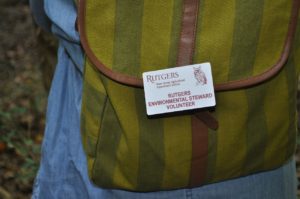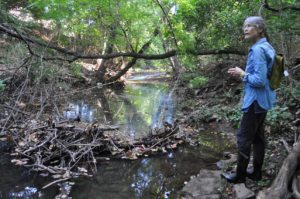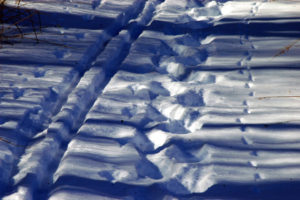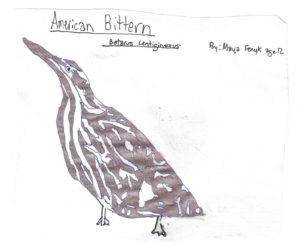Photos and article by Michele Bakacs, Environmental and Resource Management Agent, Cooperative Extension of Middlesex County, Rutgers New Jersey Agricultural Experiment Station

Through a relatively new program sponsored by Rutgers University Cooperative Extension, citizens throughout the Lower Raritan Watershed are working to help people discover the hidden natural world flowing through their communities. These citizens are part of the Rutgers Environmental Steward program and their projects range from conducting stream habitat assessments to developing middle school illustration lessons highlighting the flora and fauna of the watershed.
The goal of the Rutgers Environmental Steward program is to help citizens understand the science behind pressing environmental issues and help create positive environmental change in their communities. Susan Edmunds from Highland Park is one such Environmental Steward working on assessing the health of Mill Brook, a tributary of the Lower Raritan River.
“My goal is to bring an awareness of the Mill Brook to the community so we can work to protect it and use it as an asset. I have realized the most important thing to do is just talk to people about the brook. So many people just don’t know it is there. It would be nice to be able to take a stroll along the brook in some of the already existing parks.”
One morning in September, we scramble down a steep ravine and climb down over branches to the brook. The brook is hidden behind chain link fences, railroad overpasses, and overgrown vegetation. Once you are there you can’t believe how beautiful it is. We are transported to a natural world where the gurgling stream winds its way past towering locusts and silver maple canopy trees, and through sandstone and shale outcrops. Of course we see garbage and dumping typical of every urban waterway- the stereotypical abandoned tire and shopping cart, down trees across the stream collecting trash showing you just how damaging plastic water bottles can be to our environment when not disposed of properly. But except for the occasional train coming by as a reminder, you can barely tell how close we are to houses, roads, and train tracks. There’s the sounds of birds, leaves blowing, shadows and sunlight peaking through the trees on the water. The brook is a hidden gem waiting to be discovered by anyone who makes the effort to find it.
“The Environmental Stewards program was exactly what I hoped it would be in that I gave me a way to start getting involved with environmental protection in my community.”

Environmental Steward Susan Edmunds Assesses Mill Brook
Mapping Mill Brook is the project Susan chose for her Rutgers Environmental Steward internship. After attending about 60 hours of classes that start in January and run through June, Stewards complete an internship project of their choosing in order to become a certified Rutgers Environmental Stewards. The program welcomes non-scientists and links them with members of the academic community, government, and non-profits. The curriculum includes classes, field trips, and an internship. Once Susan is done mapping her section of Mill Brook she will summarize her findings for the Lower Raritan Watershed Partnership who will use her work to prioritize sections of the Lower Raritan for monitoring, restoration, and clean up.
“Already this project has connected me with so many people who are just like me in that they want to clean up this stream. From this assessment I plan to create a presentation about the brook and its history. I am excited about the potential for a Friends of the Mill Brook group working together towards stream access. This assessment is just the beginning of my journey.”
During the assessment, Susan takes pictures of deteriorating culverts, tree snags that collect garbage and stormdrain outfalls- concrete pipes that empty the rainwater runoff from local roads into the stream. We walk into a steep ravine probably 25 feet high with sandstone and shale outcrops leading to a large culvert where the stream flows under the NJTransit’s train tracks. This ends today’s journey and we turn around to make our way back to civilization.
If you are like Susan, and looking to start your own journey helping to protect the local environment, then sign up for the 2017 Rutgers Environmental Stewards class. Classes start in January in 5 counties throughout the state including Middlesex County at the EARTH Center in South Brunswick, and Somerset County at Duke Farms. For more information contact Michele Bakacs, at 732-398-5274, mbakacs@rutgers.edu, or visit our website http://envirostewards.rutgers.edu/
Article and photos by Joe Mish

The hiker skier and the fox
passed this way on a snowy walk
The same path was taken on that day
Though each saw things a different way
Dawn was hardly accomplished when the charcoal sky, stirred by a strong cold wind, began to hurl sharp ice crystals against the dry fallen leaves. The High velocity ice pellets struck the forest floor to reverberate against the dry leaves and create a mesmerizing steady hum.
The expansive old woods, now under siege by the late November weather, had a logging road cut through it sometime in the past that now resembled a linear scar threading through the trees. The thick canopy of branches blocked the sunlight to prevent the cut from healing and provided an unobstructed view and silent pathway, for at least a hundred yards. Any bird or animal travelling across the woodlot could be easily seen.
From my vantage point, where the road curved around a large boulder to the straightaway before me, I paused to take in the view. The falling ice began to accumulate; it was like watching an invisible hand weave a white rug on a rough umber tinted latticework. The ice would take turns with large snowflakes as this tandem team laid down white pavement on the road. The thick canopy of branches in the surrounding woods prevented much of the falling snow from reaching the ground. The white flakes and ice crystals that fell here resembled a light scattering of powdered sugar that stood in stark contrast to the near solid white woods road.
The woods are transformed with a light snow as hidden pathways and game trails show up as white lines and the thick woods instantly fitted with clear windows into the woodland depths. Any animal previously hidden by the labyrinth of branches in the one dimensional muted background of similar color, now are exposed as dark forms against white as they pass through these previously invisible portals. The slightest movement, even at a distance, now betrays an animal’s presence as sound becomes an irrelevant turncoat.
Feeling chilled, I was about to resume my walk when a quick movement in the woods caught my eye. Like watching a silent movie in black and white, a woodland drama was about to unfold.
Some small, fast animal was running along the ground in a straight line, on a course that would take it across the woody lane. In short order it appeared in the open and I was still questioning its identity. I could now see this was clearly a bird as it looked like a pigeon, though slightly larger. It was so odd to see a bird running instead of flying and given its speed, its health did not seem compromised. The fleet footed bird was a ruffed grouse! I recalled seeing grouse feeding in the predawn light on other occasions and thinking how they resembled pigeons.
In less than 15 seconds, another larger form appeared and was clearly running along the same track as the grouse. This was a red fox!
The fox had probably gotten a glimpse of the grouse, lost sight of the bird, then picked up its scent to begin the chase. The grouse felt confident enough it could escape on the ground as the fox was in steady but lagging pursuit.
The bird would take to the air if the fox came within striking distance and barring intervention from a hungry cooper’s hawk, the grouse would enjoy the rest of the day in peace. The fox was on a foolish pursuit chasing an alert grouse. Its hunger in full argument with its experience arrived at a compromise and the chase began in deference to hunger.
I waited another few minutes and couldn’t resist trying to call the fox in. Like magic the fox came running, sat at the edge of the lane in the white snow and stared in my direction for a good minute, stood up and trotted off.
As the fox disappeared in the distant woods I again began to walk down the canopied lane enjoying the snowy woods.
The old logging road weaving through the trees scattered with snow brought the lines from poet Robert Frost to life. From “A road not taken”:
“… and looked down one (road) as far as I could, to where it bent into the overgrowth”.
Then the line from Stopping by the woods on a snowy evening:
“…to watch his woods fill with snow”……
“The only other sound’s the sweep
Of easy wind and downy flake.”
Unwrap the gift of a light November snow and enjoy sights and sounds that have inspired the verse of American Poets.
Author Joe Mish has been running wild in New Jersey since childhood when he found ways to escape his mother’s watchful eyes. He continues to trek the swamps, rivers and thickets seeking to share, with the residents and visitors, all of the state’s natural beauty hidden within full view. To read more of his writing and view more of his gorgeous photographs visit Winter Bear Rising, his wordpress blog. Joe’s series “Nature on the Raritan, Hidden in Plain View” runs monthly as part of the LRWP “Voices of the Watershed” series. Writing and photos used with permission from the author.
By Maya Fenyk (age 12), LRWP youth consultant and “Endangered & Threatened Species” series contributor

American Bittern, by Maya Fenyk (age 12)
Hi! I am Botaurus Lentiginosis but you can call me Anthony, the American Bittern. I live in thick marshy areas that are dense with vegetation, such as wetlands or freshwater marshes. Unfortunately humans have destroyed and drained most of my natural habitat. This act alone almost diminished my population to 0 throughout the first half of the 20th century. Sadly my species faces even more threats to our survival, such as hunting. Even now in the 21st century where we have a lot of environmentalists looking out for us, there still aren’t enough protective measures in place to take us off the Endangered Species list. We are a shy bird, hard to research, and the amount of American Bitterns in New Jersey is still unknown. Scientists aren’t even sure if our population is increasing or decreasing!
Not much can be done by the ordinary citizen to help bring back our population. I would ask, though, that you don’t hunt my species, and if you see me report the sighting to an environmental agency pronto. I also have a favor to ask of the big development companies. Stop developing on wetlands and other habitats of animals! The act of developing on our homes alone severely destroys our species and others alike. But it’s not just for my sake I am saying this, wetlands are a natural barrier between water and other habitats (of animals and humans). And wetlands decrease flooding risk, which could potentially save lives.
If you saw my species regularly, which I doubt since our feathers camouflage us into the reeds of our marshy habitat, you would say we are kind of cute. We are a stocky medium-sized wading bird that is striped white and brown on our heads, neck and upper part of our body for the rest we are light brown. But watch out, even though we are shy and prefer the flight response instead of fight if we are corned we will use our yellow spear-like bill! At each stage of our life cycle we are pretty cute too. We hatch at about 24 days and stay in the nest for 2 weeks but even after we fledge we remain dependent on our mom for food and shelter for another two weeks.
Humans, don’t worry. Even though I have a spear-like bill I won’t eat you. But still, don’t approach me. My species eats small mammals, amphibians, reptiles, crustaceans, mollusks, fish, and insects. And even though I am the Lower Raritan Watershed’s resident American Bittern, my species can be found from Canada to Mexico! Thank you for reading about me today – and please make a pledge that you won’t damage my habitat further, right? Now excuse me I hear a great horned owl – I must hide! Kok-Kok-Kok. (that’s the sound of my call).




